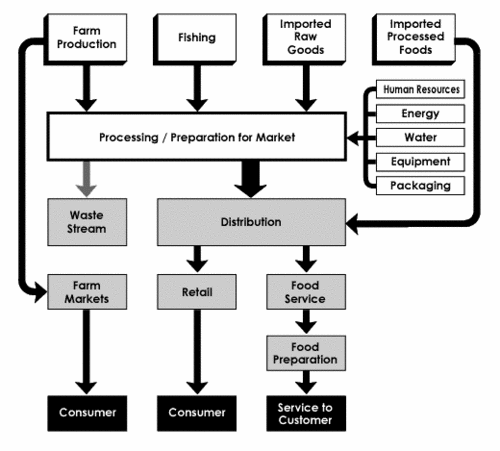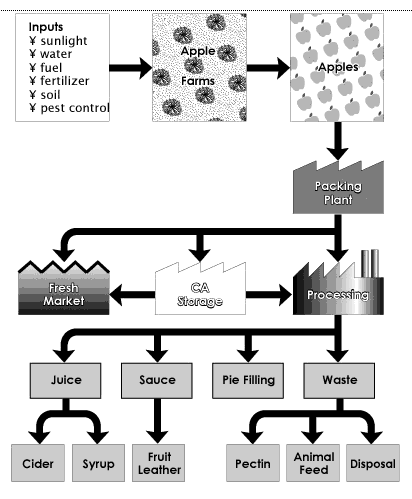Course:FNH200/Lessons/Lesson 01
Food Science and the Canadian Food System
01.0 Overview
In this lesson, we will define the field of food science, and discuss the size and scope of the food industry in Canada. We will take a look at food production, importation, and distribution within Canada. Apple production and processing will be discussed as an example of the conversion of an agricultural product into a variety of food products. Finally, we will monitor some food consumption patterns and trends which have occurred over the past 40 years.
Objectives
After completing this lesson, you should be able to:
- describe the field of Food Science;
- describe the breadth and relative magnitude of various sectors of the Canadian food industry;
- identify the trends in food consumption in Canada;
- illustrate the ways that foods are distributed to consumers in Canada; and
- discuss how apples are converted into a variety of food products and how they are stored
Optional Reading
Top 10 Food Trends for 2019: http://www.ift.org/food-technology/past-issues/2019/april/features/2019-top-10-food-trends.aspx
01.1 What is the Definition of Food Science?
Foods, as such, are complex systems subject to many forms of changes, including biochemical, nutritional, physical, and/or sensory changes. The multidisciplinary science known as food science is used to pull together the wide range of knowledge that deals with food.
Food Science can be defined as the application of the principles of science, engineering, and mathematics in order to study and acquire new knowledge on the physical, chemical, and biochemical nature of foods. Food science is a broad field that is composed of specializations in food microbiology, food chemistry, and food engineering. Food science also involves the study of sensory properties of food, and therefore, the psychology of food choice. From the information gathered by food science, the corresponding technologies can be applied to the utilization, processing, preservation, and storage of food. This is known as food technology.
Here is a brief explanation of the main components (sub-fields) of Food Science(adapted from Potter and Hotchkiss, 1995):
- Food Chemistry: deals with the composition, structure and properties of food, as well as the chemistry of changes that occur during processing.
- Food Analysis: covers the principles and methods for quantitative physical and chemical analyses of food products and ingredients. These analyses are related to the standards and regulations for food processing.
- Food Microbiology: relates to the study of microbial ecology in relation to food, the effect of environment on food spoilage and food manufacture, the physical, chemical, and biological destruction of microorganisms in food, the microbiological examination of food stuffs, and public health and sanitation microbiology.
- Food Processing: covers the principles of food preservation and the general characteristics of raw food materials, processing factors that influence quality, packaging, waste management, good manufacturing practices, and sanitation procedures.
- Food Engineering: relates to the study and application of engineering concepts and unit operations used in food processing. Engineering principles include material and energy balances, thermodynamics, fluid flow, and heat and mass transfer.
Are Food Science and Nutrition the same?
"the difference between food science and nutrition is that nutrition deals with the effects of foods in the person who consumes them, while food science is concerned with the study of the chemical, microbiological, physical, and sensory properties of foods and their ingredients during processing, manufacture, and storage." Murano (2003)
01.2 How Old is the Discipline of Food Science?


Food science as a distinct discipline is quite new. However, many aspects of "food science" have existed for many centuries. Products derived from food fermentation (biotechnology) have existed for thousands of years. For example, there is evidence that people were fermenting beverages in (A) Babylon circa 5000 BC, (B) ancient Egypt circa 3000 BC, and (C) pre-Hispanic Mexico circa 2000 BC. Today we know that fermentation not only contributes to a wide variety of food products, but it also involves food processing and preservation.
Another example dates back to 1795, when Emperor Napoleon offered 12,000 francs for a new way of preserving food for its army. It was the French confectioner François Nicolas Appert who won the prize by placing food in wide-mouthed bottles, then corking and heating them in a water bath. The existence of bacteria was not known at the time, and Appert did not know the principle upon which his process depended; however, he was correct in the thought that heat could preserve food. Appert is therefore known as the discoverer of the process later known as canning.
| Want to learn more? |
|
01.3 Extent of Canada's Food System

In Canada, we have a diverse food system with thousands of food products available for purchase. Those products include foods produced in Canada as well as food products imported from many countries around the world.
The Canadian food system is depicted in Figure 1.3. Foodstuffs (fruit, vegetables, cereal grains, oilseeds, animals, and fowl) are produced by farmers involved in primary agricultural production. Fin fish, molluscs, and crustaceans are harvested from the wild or raised on fish farms. Unprocessed foodstuffs and fish are also imported for sale or processing in Canada. These products are shipped directly to farmers' markets, processors, or distributors. Many agricultural and fishery products undergo some form of processing/preservation prior to distribution to the consumer market. Many foods are fabricated from the foodstuffs produced by primary agricultural and fishery harvesting. Examples of fabricated foods are bread, smoked and cured luncheon meats, soft drinks, yogurt, and chewing gum, to name a few.
Food products from processors or primary producers often pass through various distributors before they reach retail stores or food service outlets. Foods are retailed through chain stores and smaller independent stores, as well as numerous convenience stores which may be part of a chain or may be owned by an independent operator, as well as food co-operatives.
- Vegetables are sold in the fresh market as well as being processed (canned, frozen, dehydrated, or fermented) to increase storage life.
- Greenhouse production of vegetables is an increasingly important component of the fresh market supply (cucumbers, peppers, lettuce, and tomatoes) particularly in the fall and winter seasons.
- Seafood products are harvested and processed primarily in Atlantic Canada and in British Columbia. Seafood production includes the harvesting of wild stocks as well as production of salmon, oysters, clams, and lobsters, under intensive production systems ('farmed' seafood). Cultivation of fish (trout) in fresh water occurs in a number of regions of Canada.
- Some products are transferred to the consumer market with a minimum of processing (e.g. fresh fruits and vegetables) while others (e.g. beef, pork, poultry, milk, and wheat) go through more extensive processing before being transported to the retail market. Many agricultural products (e.g. wheat flour, corn flour, corn starch, corn syrup, fruits, vegetables, milk, and milk components) become sources of ingredients for the production of other food products.
Below are the major Provinces in Canada involved in the production of different agricultural food commodities:
| Food commodity production | Province |
|---|---|
| Animal (beef, pork, poultry) | Widespread around Canada |
| Dairy milk production | Across Canada, Ontario, Quebec |
| Cereal grains | Alberta, Saskatchewan, Manitoba |
| Tree fruit; small fruits; cranberries, blueberries, raspberries | British Columbia; Ontario, Nova Scotia; Almost every province; British Columbia |
| Vegetables | All across Canada |
| Seafood | Atlantic Canada and British Columbia |
Many agricultural commodities, finished food products and ingredients are imported into Canada as well. These imported products must meet the same standards and regulatory requirements as foods produced in Canada. This aspect is discussed in more detail in the section of the course dealing with regulatory issues and standards (Lesson 4).
| Want to learn more? |
| How does a trading store (ca. 1910) compare to the typical grocery store (supermarket) of today?
- Food production and marketing have come a long way since the 1900s |
01.4 The Canadian Food Industry
The Canadian food industry is a multi-billion dollar a year industry. Foods available to us on the grocery store shelves include both domestically produced products and imported foods.
| Want to learn more? |
|
Although Canada produces large amounts of fruits and vegetables, vast quantities of fruits and vegetables are imported as fresh product and in lesser amounts as frozen, canned, and dehydrated products. This is due to the seasonal nature of fruit and vegetable production in Canada, as well as the need for climates warmer than Canada to grow fruits such as oranges, grapefruit, and bananas.
Canada exports meat products (raw meat and processed meat products) to other countries but also imports meat products (raw meats of specific cuts that may be in short supply in Canada, as well as processed meat products). Likewise, Canada exports raw fish (fresh and frozen salmon, cod, etc.) and processed fish (canned fish, smoked fish, salmon, and herring roe) to other countries, while other types of fish (such as prawns, oysters, and processed fish products) are imported into Canada.
01.5 Apples and Apple Products

The processing of apples will be used as an example of the utilization and conversion of an agricultural commodity to various food products and ingredients (Fig. 1.4). After harvesting, apples can be routed several directions: they can be shipped directly to the fresh market; they can be processed; or they can be put into controlled atmosphere storage facilities where the atmosphere, temperature and humidity are carefully controlled to retard the rate of respiration and ripening of the apples, thus extending the storage life of the fresh fruit. Controlled atmosphere storage of apples is described at:
Apples can be processed in various ways. A large proportion of processing apples is converted to apple juice. The type of apple juice preferred by consumers in Western Canada is the clear apple juice. Apple juice can be used as the starting material for the production of apple cider. In making cider, apple juice is inoculated with specific yeast strains which ferment sugar in the juice into ethanol and produce flavours characteristic of apple cider. Apple cider can be further processed by inoculating it with a bacterial culture that will oxidize the ethanol to acetic acid to produce apple vinegar.
The apple solids remaining after juice extraction can be used as a feed material for the production of pectin (a carbohydrate used as gelling agent in the production of jams and jellies), animal feed, or as organic matter that can be returned to agricultural lands. In some cases, the residue may also be trucked to landfill sites which adds to the waste burden entering those sites.
Apples are also processed into apple sauce and pie fillings. A greater proportion of these products are used as ingredients in the bakery and food service industries than as items in retail stores.
To a lesser extent, apples are used to produce dehydrated apple slices, fruit leather, apple-filled snack bars and as ingredients for some confectionary products and breakfast cereals.
| Want to learn more? |
|
01.6 Trends in Food Consumption in Canada
Overall, many changes have occurred in food consumption patterns in Canada in the past few decades, and they continue to change as consumer demands and perceptions change. The advent of new processing technologies have brought new products on the market and this will continue. Consumer perception of those products will determine whether they succeed or fail. Undoubtedly, advertising campaigns for various food products and controversies about the health effects of various food commodities (butter vs margarine; sugar vs non-caloric or low caloric sweeteners; fats vs fat substitutes; trans-fat free products; processed vs unprocessed foods) will continue to influence consumer food buying habits.
| Want to learn more? |
|
| Critical Thinking |
|
01.7 Summary of Lesson 1
- Food science studies the production, processing, preparing, evaluating, and use of food
- Technological advancements have led to many "food science discoveries"
- Canada offers a vast and diverse food system
- The Canadian food industry has a strong impact on Canada's economy
- Consumers and consumer demands have a strong influence on the food consumption trends
Closing thoughts
In conclusion, the food industry in Canada is a large industry that provides employment for a substantial part of the workforce in Canada. The variety of food products available in grocery stores or through food service outlets is immense and is likely to grow in response to consumer demands and changes in demographics, health, animal welfare, and environmental concerns.
At this point, it is important to recognize that while the amount and variety of foods consumed in Canada are increasing, many people in other parts of our world are unable to even secure enough nutritious food to maintain a healthy lifestyle. It has been estimated that about 3/4 of the world population live in lesser developed countries which are found mainly in Africa, Asia, and South/Central America. Most of the inhabitants of these countries cannot get enough nutritious food to eat each day. Nutrients in short supply, include fat, protein, vitamins, minerals, and clean/safe drinking water. It is important to keep that thought in mind as you proceed through the course.
References
- Murano, P.S. (2003). Introduction to Food Science and Technology. Understanding Food Science and Technology (Chapter 1). Belmont, California: Thompson Wadsworth.
- Potter, N. N. & Hotchkiss,J. H. (1998). Characteristics of the Food Industry. Food Science (5th ed.) (Chapter 2). Gaithersburg, Maryland: Aspen Publishers, Inc.
- Potter, N. N. & Hotchkiss,J. H. (1998). Vegetables and Fruits. Food Science (5th ed.) (Chapter 18 & pp.432-434). Gaithersburg, Maryland: Aspen Publishers, Inc.
- Food Available in Canada. Statistics Canada.https://www150.statcan.gc.ca/t1/tbl1/en/tv.action?pid=3210005401&pickMembers%5B0%5D=1.1&pickMembers%5B1%5D=3.1 (Links to an external site.)
- Food Technology Magazine Editors Share Top 10 Food Trend Predictions for 2019. http://www.ift.org/food-technology/past-issues/2019/april/features/2019-top-10-food-trends.aspx (Links to an external site.)
Authorship:
FNH 200 Course content on this wiki page and associated lesson pages was originally authored by Drs. Brent Skura, Andrea Liceaga, and Eunice Li-Chan. Ongoing edits and updates are contributed by past and current instructors including Drs. Andrea Liceaga, Azita Madadi-Noei, Nooshin Alizadeh-Pasdar, and Judy Chan.
|
|